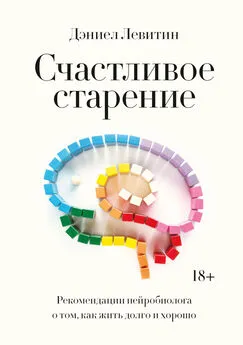Дэниел Левитин - Счастливое старение. Рекомендации нейробиолога о том, как жить долго и хорошо
- Название:Счастливое старение. Рекомендации нейробиолога о том, как жить долго и хорошо
- Автор:
- Жанр:
- Издательство:Манн, Иванов и Фербер
- Год:2021
- Город:Москва
- ISBN:9785001695868
- Рейтинг:
- Избранное:Добавить в избранное
-
Отзывы:
-
Ваша оценка:
Дэниел Левитин - Счастливое старение. Рекомендации нейробиолога о том, как жить долго и хорошо краткое содержание
Ответы на эти и многие другие вопросы вы найдете в книге известного нейробиолога и автора бестселлеров о природе возрастных изменений и о том, как можно прожить долго и что нужно делать сейчас (в любом возрасте), чтобы в 70, 80 и 90 жить полной жизнью.
Книга предназначена для широкого круга читателей.
На русском языке публикуется впервые.
Счастливое старение. Рекомендации нейробиолога о том, как жить долго и хорошо - читать онлайн бесплатно ознакомительный отрывок
Интервал:
Закладка:
G. Tse and G. D. Eslick, “Cruciferous Vegetables and Risk of Colorectal Neoplasms: A Systematic Review and Meta-Analysis,” Nutrition and Cancer 66, no. 1 (2014): 128–139.
R. W.-L. Ma and K. Chapman, “A Systematic Review of the Effect of Diet in Prostate Cancer Prevention and Treatment,” Journal of Human Nutrition and Dietetics 22, no. 3 (2009): 187–199.
M. Loef and H. Walach, “Fruit, Vegetables and Prevention of Cognitive Decline or Dementia: A Systematic Review of Cohort Studies,” Journal of Nutrition, Health and Aging 16, no. 7 (2012): 626–630.
J. D. Potter and K. Steinmetz, “Vegetables, Fruit and Phytoestrogens as Preventive Agents,” IARC Scientific Publications 139 (1996): 61–90.
H. Steinkellner et al., “Effects of Cruciferous Vegetables and Their Constituents on Drug Metabolizing Enzymes Involved in the Bioactivation of DNA-Reactive Dietary Carcinogens,” Mutation Research/Fundamental and Molecular Mechanisms of Mutagenesis 480 (2001): 285–297.
H. H. Nguyen et al., “The Dietary Phytochemical Indole-3-Carbinol Is a Natural Elastase Enzymatic Inhibitor That Disrupts Cyclin E Protein Processing,” Proceedings of the National Academy of Sciences 105, no. 50 (2008): 19750–19755.
F. Fuentes, X. Paredes-Gonzalez, and A. N. T. Kong, “Dietary Glucosinolates Sulforaphane, Phenethyl Isothiocyanate, Indole-3-Carbinol/3, 3´-Diindolylmethane: Antioxidative Stress/Inflammation, Nrf2, Epigenetics/Epigenomics and in Vivo Cancer Chemopreventive Efficacy,” Current Pharmacology Reports 1, no. 3 (2015): 179–196.
K. J. Royston and T. O. Tollefsbol, “The Epigenetic Impact of Cruciferous Vegetables on Cancer Prevention,” Current Pharmacology Reports 1, no. 1 (2015): 46–51.
595
Grand View Research, “Omega 3 Supplement Market Analysis by Source (Fish Oil, Krill Oil), by Application (Infant Formula, Food and Beverages, Nutritional Supplements, Pharmaceutical, Animal Feed, Clinical Nutrition), and Segment Forecasts, 2018–2025,” May 2017, https://www.grandviewresearch.com/industry-analysis/omega-3-supplement-market; Statista, “Global Omega-3 Supplement Market Size in 2016 and 2025 (in Billion US Dollars),” 2016, https://www.statista.com/statistics/758383/omega-3-supplement-market-size-worldwide/.
596
A. S. Abdelhamid et al., “Omega-3 Fatty Acids for the Primary and Secondary Prevention of Cardiovascular Disease,” Cochrane Database of Systematic Reviews 11 (2018).
597
NIH National Center for Complementary and Integrative Health, “Omega-3 Supplements: In Depth,” 2018, https://nccih.nih.gov/health/omega3/introduction.htm.
598
H. LeWine, “Fish Oil: Friend or Foe?” Harvard Health Publishing, 2019, https://www.health.harvard.edu/blog/fish-oil-friend-or-foe-201307126467.
599
S. E. Brien et al., “Effect of Alcohol Consumption on Biological Markers Associated with Risk of Coronary Heart Disease: Systematic Review and Meta-Analysis of Interventional Studies,” British Medical Journal 342 (2011): d636.
600
A. Artero et al., “The Impact of Moderate Wine Consumption on Health,” Maturitas 80, no. 1 (2015): 3–13.
601
World Cancer Research Fund and American Institute for Cancer Research, Food, Nutrition, Physical Activity, and the Prevention of Cancer: A Global Perspective, vol. 1 (Washington, DC: American Institute for Cancer Research, 2007).
602
L. Schwingshackl and G. Hoffmann, “Adherence to Mediterranean Diet and Risk of Cancer: An Updated Systematic Review and Meta-Analysis of Observational Studies,” Cancer Medicine 4, no. 12 (2015): 1933–1947.
603
Pérez-López et al., “Effects of the Mediterranean Diet”; O. Vang et al., “What Is New for an Old Molecule? Systematic Review and Recommendations on the Use of Resveratrol,” PLoS One 6, no. 6 (2011): e19881.
604
J. M. Smoliga, J. A. Baur, and H. A. Hausenblas, “Resveratrol and Health – a Comprehensive Review of Human Clinical Trials,” Molecular Nutrition and Food Research 55, no. 8 (2011): 1129–1141.
605
D. G. Loughrey et al., “The Impact of the Mediterranean Diet on the Cognitive Functioning of Healthy Older Adults: A Systematic Review and Meta-Analysis,” Advances in Nutrition 8, no. 4 (2017): 571–586.
606
O. van de Rest et al., “Dietary Patterns, Cognitive Decline, and Dementia: A Systematic Review,” Advances in Nutrition 6, no. 2 (2015): 154–168.
607
J. Brody, “Muscle Loss in Aging Can Be Reversed,” The New York Times, September 4, 2018, p. D5.
608
United States Department of Agriculture, Agricultural Research Service, USDA Food Composition Databases, n.d., https://ndb.nal.usda.gov/ndb/nutrients/index.
609
Brody, “Muscle Loss in Aging.”
610
US National Library of Medicine, National Center for Biotechnology Information, PubChem Database, Leucine, CID 6106, 2019, https://pubchem.ncbi.nlm.nih.gov/compound/6106.
611
R. Elango et al., “Determination of the Tolerable Upper Intake Level of Leucine in Acute Dietary Studies in Young Men,” American Journal of Clinical Nutrition 96, no. 4 (2012): 759–767; A. G. Wessels et al., “High Leucine Diets Stimulate Cerebral Branched-Chain Amino Acid Degradation and Modify Serotonin and Ketone Body Concentrations in a Pig Model,” PLoS One 11, no. 3 (2016): e0150376; M. Yudkoff et al., “Brain Amino Acid Requirements and Toxicity: The Example of Leucine,” Journal of Nutrition 135, no. 6 (2005): 1531S–1538S.
612
M. Messina, “Soy and Health Update: Evaluation of the Clinical and Epidemiologic Literature,” Nutrients 8, no. 12 (2016): 754.
613
E. Dolhun, “Aftermath of Typhoon Haiyan: The Imminent Epidemic of Waterborne Illnesses in Leyte, Philippines,” Disaster Medicine and Public Health Preparedness 7, no. 6 (2013): 547–548.
614
C. Troeger et al., “Estimates of the Global, Regional, and National Morbidity, Mortality, and Aetiologies of Diarrhoea in 195 Countries: A Systematic Analysis for the Global Burden of Disease Study 2016,” Lancet Infectious Diseases 18, no. 11 (2018): 1211–1228; C. Trinh and K. Prabhakar, “Diarrheal Diseases in the Elderly,” Clinics in Geriatric Medicine 23, no. 4 (2007): 833–856.
615
Из личного общения с доктором медицины Эдуардо Долхуном 21 февраля 2017 года.
616
D. R. Thomas et al., “Understanding Clinical Dehydration and Its Treatment,” Journal of the American Medical Directors Association 9, no. 5 (2008): 292–301.
617
World Health Organization, “Diarrhoeal Disease,” 2017, https://www.who.int/news-room/fact-sheets/detail/diarrhoeal-disease.
618
Из личного общения с Эдуардо Долхуном.
619
К сожалению, многие растворы ОРС неприятны на вкус, из-за чего люди, которым они необходимы, не хотят их пить. В некоторые такие продукты для улучшения вкуса добавлен рафинированный сахар, что дает обратный эффект. Я рекомендую раствор DripDrop, который разработал мой коллега врач Эдуардо Долхун. Он проходил подготовку в клинике Mayo и регулярно участвует в гуманитарных миссиях в развивающихся странах, где лечит обезвоживание с помощью своего продукта. У меня нет финансовой заинтересованности в деятельности этой компании, и я не извлеку никакой выгоды, если вы будете покупать этот продукт. Список рекомендаций можно посмотреть здесь: Eduardo P. Dolhun, Oral rehydration composition, US Patent 8,557,301, filed July 1, 2011, and issued October 15, 2013, https://patentimages.storage.googleapis.com/bd/54/5b/cd03de0b6f973c/US8557301.pdf.
620
D. Gandell et al., “Treatment of Constipation in Older People,” CMAJ 185, no. 8 (2013): 663–670.
621
Y. Li et al., “Hippocampal Gene Expression Profiling in a Rat Model of Functional Constipation Reveals Abnormal Expression Genes Associated with Cognitive Function,” Neuroscience Letters 675 (2018): 103–109.
622
Y. M. I. Kazem et al., “Constipation, Oxidative Stress in Obese Patients and Their Impact on Cognitive Functions and Mood, the Role of Diet Modification and Foeniculum vulgare Supplementation,” Journal of Biological Sciences 17, no. 7 (2017): 312–319; R. T. Wang and Y. Li, “Analysis of Cognitive Function of Old People with Functional Constipation,” Journal of Harbin Medical University 6 (2011): 603–605.
623
A. Low, “Treating Constipation with Laxatives,” 2010, GI Society: Canadian Society of Intestinal Research, https://www.badgut.org/information-centre/a-z-digestive-topics/treating-constipation-with-laxatives/.
624
Один из препаратов этой фармакологической группы, используемый в США. Прим. ред.
625
A. Evrensel and M. E. Ceylan, “The Gut-Brain Axis: The Missing Link in Depression,” Clinical Psychopharmacology and Neuroscience 13, no. 3 (2015): 239; Y. E. Borre et al., “Microbiota and Neurodevelopmental Windows: Implications for Brain Disorders,” Trends in Molecular Medicine 20, no. 9 (2014): 509–518.
626
C. Rousseaux et al., “Lactobacillus acidophilus Modulates Intestinal Pain and Induces Opioid and Cannabinoid Receptors,” Nature Medicine 13, no. 1 (2007): 35.
627
M. Valles-Colomer et al., “The Neuroactive Potential of the Human Gut Microbiota in Quality of Life and Depression,” Nature Microbiology 1 (2019).
628
T. G. Dinan and J. F. Cryan, “Melancholy Microbes: A Link between Gut Microbiota and Depression?” Neurogastroenterology and Motility, no. 25 (2013): 713–19.
629
Borre et al., “Microbiota and Neurodevelopmental Windows.”
630
Evrensel and Ceylan, “The Gut-Brain Axis”; J. F. Cryan and T. G. Dinan, “Mind-Altering Microorganisms: The Impact of the Gut Microbiota on Brain and Behaviour,” Nature Reviews Neuroscience 13, no. 10 (2012): 701.
631
Cryan and Dinan, “Mind-Altering Microorganisms”; E. G. Severance et al., “Discordant Patterns of Bacterial Translocation Markers and Implications for Innate Immune Imbalances in Schizophrenia,” Schizophrenia Research 148, nos. 1–3 (2013): 130–137; A. I. Petra et al., “GutMicrobiota-Brain Axis and Its Effect on Neuropsychiatric Disorders with Suspected Immune Dysregulation,” Clinical Therapeutics 37, no. 5 (2015): 984–995; F. Dickerson, E. Severance, and R. Yolken, “The Microbiome, Immunity, and Schizophrenia and Bipolar Disorder,” Brain, Behavior, and Immunity 62 (2017): 46–52.
Читать дальшеИнтервал:
Закладка:








![Дэниел Левитин - Путеводитель по лжи [Критическое мышление в эпоху постправды]](/books/1101191/deniel-levitin-putevoditel-po-lzhi-kriticheskoe-my.webp)

